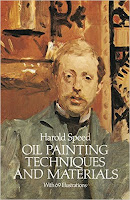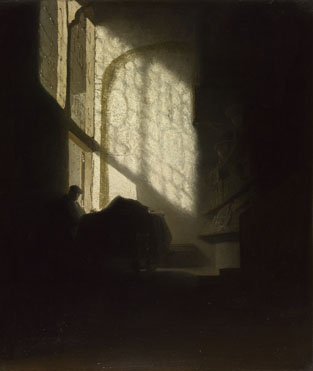
Today we'll take a look at Chapter 5: "Tone Values" from Harold Speed's 1924 art instruction book
Oil Painting Techniques and Materials
.
I'll present Speed's main points in boldface type either verbatim or paraphrased, followed by comments of my own. If you want to add a comment, please use the numbered points to refer to the relevant section of the chapter.
1. Beauty in tone values comes from tones that are large and simple.
Speed points out that this isn't the only kind of pictorial beauty, but it's an important one. What he means by large and simple tones is big, unbroken shape of tone. We've talked about this principle in terms of "
Shape Welding."
It also has do do with the modeling of form, where the light areas are grouped into close values to give a sense of a flat poster-like appearance, even if there is subtle glazing and variation, as in the Velazsquez below.
He makes the analogy with music often in this chapter as he has done elsewhere, comparing the "big tone" approach with a pure note on a violin. He also mentions that using opaque paint gives greater tonal control. In fact with opaques it can be a challenge to get variety and color change.
2. "The thick atmosphere of our towns simplifies the tones, and is responsible for much of the beauty our artists find in such unexpected places of manufacture."
A nice side benefit of smog from coal in London 100 years ago, where the air was so polluted you couldn't see to the end of the block.
3. Tone beauty not important to the Pre-Raphaelite Brotherhood (PRB).
Speed isn't knocking them exactly, but just saying they were after other pictorial goals. Ruskin, a friend and champion of the PRB and other super-naturalist painters, was a great fan of microscopic detail, and also an advocate of gradation, rather than the flat-tone approach of Whistler, Brangwyn, and the Newlyn School. Speed makes a few exceptions among PRB painters, such as the Blind Girl by Millais, which is reproduced in my book Color and Light.
4. Velazquez was the great master of tone values.
Carolus-Duran, Sargent's teacher, was also a huge fan of Velazquez, and much of Sargent's love of the big tone approach came from him. Pyle of course in this country was a big tone fan, and I've talked about that on this blog quite a bit.

5. Head of Aesopus (Aesop, i.e. of Fable fame) probably painted with warm and cold black, burnt sienna and white.
Here's the image Speed is referring to. Has anyone tried this? By the way, I love using a warm black and a cool black in watercolor, too. A cool black might be Payne's Gray, and a warm black might be Sepia, for example.
 |
| Vermeer, Lady at the Virginal |
6. Vermeer's technique
I don't have time to recapitulate Speed's points here, but maybe some of you who have experimented with the methods Speed is talking about would care to comment.
7. "Strongly contrasted schemes of tone had been in use since the days of Leonardo da Vinci, but used chiefly to augment the expression of form; whereas Rembrandt used it as an expressive thing in itself, giving it aesthetic value."
"The Philosopher" by Rembrandt, above, may be different from the one Speed showed in the book, but it makes the same point. Intriguing big tones. EDIT: The one Speed referred to is below (thanks, Steven).
A Man seated reading at a Table in a Lofty Room
about 1628-30, Follower of Rembrandt
8. "What is often called muddy colour is generally the result of bad tone relationships."
A very important point that has come up before and will come up again here.

Next week—Chapter 6: Elementary Tone Exercises
-----











































